IN MY SKY AT TWILIGHT 해 질 녘 나의 하늘에는
2015
Sungkok Art Museum, Seoul, South Korea
*List of Works:
-My Meursault 나의 뫼르소_sound & video installation_5min 5sec, 3min 20sec_2015
-A Reverie in the Fog 안개 잠_video installation_fog, single channel video screen(11min 36sec)_2015
-A Man Who Became a Landscape#1~3 풍경이 된 사람#1~3_single channel video_12min 6sec, 7min 29sec, 10min 44sec_2015
-The Wanderer's Song of Wind 떠도는 이들이 전하는 바람의 노래_8 channel video installation_7min 1sec, 4min 14sec, 8min 27sec, 8min 8sec, 16min 47sec, 3min 7sec, 7min 9sec, 1min 47sec_chairs, polyethylene, metal haloid lamps _2015
-Inner View 이너 뷰_installation of interviews of 8 victims of national catastrophes_2015
-Live Sun 살아있는 태양_real-time video_2015
-Tower of Nostalgia 37°81'38.98"N 126°24'54.48"E 망향탑 37°81'38.98"N 126°24'54.48"E_200×149cm, photograph_2015
-Rising Tide 36°57'81.57"N 126°31'44.49"E 밀물 36°57'81.57"N 126°31'44.49"E_70×53cm, three photographs_2015
-Sea×Girl 바다 x 소녀_90×68cm, photograph_2015
-Gate×Lady 어귀 x 여인_90×68cm, photograph_2015
-Earth Grave×Grandmother 흙무덤 x 할머니_150×113cm, photograph_2015
-Misty Sea 34°37'46.17"N 126°13'50.96"E 안개바다 34°37'46.17N 126°13'50.96"E_150×113cm photograph_2015
-Misty Sea 35°62'59.79"N 126°46'60.54"E 안개바다 35°62'59.79"N 126°46'60.54"E_150×113cm photograph_2015
-Misty Sea 34°37'44.72"N 126°13'48.04:E 안개바다 34°37'44.72"N 126°13'48.04"E_90×68cm, photograph_2015
IN MY SKY AT TWILIGHT 해 질 녘 나의 하늘에는 at Sungkok Art Museum(Seoul, 2015)
RYU Biho's solo show has been given the somewhat literary title In My Sky at Twilight by the artist himself. As this title, redolent of a very romantic, passionate love poem, has been appropriated from the collection of Pablo Neruda’s poems Twenty Poems and a Song of Despair, all the more so. This exhibition tinted with lyrical emotion offers a comprehensive overview of the films, sound artworks, photographs, and more that display his attempts to intervene in the reality that he has long been considering as an artist.
Our present society is too different to be compared to the one in the past in many respects. We are now living in an ‘unprecedented’ society reconstructed by high-technology and artificiality whereas we were once living in tune with the rhythms of nature. The environment we inhabit is not natural but artificial and technological. While our physical environment is highly technologized, our spiritual and psychological environment is often tied up with the past. For instance, the nuclear family was already a general tendency of our society whereas we still wanted to have an intricate, close knit relationship emotionally and personally as we did in the past. As a result, mismatches between our desires and reality arise, resulting in our frustration and confusion in our values, causing a multitude of never acceptable social problems. Each society has been plagued by its own specific, intrinsic drawbacks in the process of transiting to contemporary society alongside its particular traditions. No society can evade these problems. Art alone cannot stay in its own lofty, undefiled sphere, untrammeled from society’s conflict structure.
RYU Biho also intends to dig into heart-stricken issues that have plagued contemporary Korean society throughout history. Rapid industrial-ization, capitalization, and modernization tend to cause changes in the preexisting value of humanistic life. While some cling to outdated or invalid values, others see them from a different perspective, leaving them without having any regret. Those who do have regrets object from different points of view and are not only in a state of conflict or struggle but also in conciliation and compromise. Some are bound to be winners and some are bound to be losers in such struggles.
The artist expresses emotions such as longing, sympathy, sorrow, and hollowness concerning marginalized persons and forgotten, outdated, and abandoned things. He grasps and discloses aspects of our society caught in a conflict structure, trying to offer warmhearted aid and words of consolation. He intends to leave traces of his serious considerations as an artist through his social consciousness, communion with our time, and an artistic exploration of the world of imagination, dreaming of humans who see the world from a pure, unstained perspective.
This exhibition features six videos and numerous photographs that the artist has newly directed and taken. He had looked for a venue to shoot and shot with performers anchored in elaborate scenarios. We are intrigued by diverse contents and fresh video installation as well as a hard-edged reality and intrinsic poetic inspiration. In particular, in the overlap of the past scene of goryeojang (an ancient practice of abandoning an old person to die at a grave site) and the present scene, a gray-haired old man and a man with a limp conveys the message “Whom do I turn my face away from and why do I have to abandon them?” questioning what we miss in our age. It is hoped that RYU’s artistic endeavors will offer solace to the loss of social relations and humanity’s solitude, relieving the sense of defeat and impotence that contemporary humans suffer from.
By LEE Soukyoun
. Chief Curator, Sungkok Art Museum
유비호 작가는 이번 기획전에 ‘해 질 녘 나의 하늘에는’ 이라는 문학적인 제목을 붙였다. 무척 낭만적이고 격정적인 연애시를 연상케 하는 이 제목 은 파블로 네루다의 시집 ‹스무 편의 사랑의 시와 한 편의 절망의 시›에서 발췌했기에 더욱 더 그렇게 느껴진다. 이번 전시는 유비호가 오래 전부터 고민해 왔던 예술가로서의 현실 개입에 대한 구체적 시도들로서, 작가의 작품세계를 총 망라하여 제시한다.
우리가 살고 있는 현재의 사회는 과거와는 여러 가지 면에서 비교 할 수 없을 만큼 빠른 속도로 다양하게 변화하고 있다. 예를 들어 우리의 일상의 장소와 환경에 대하여 이야기 하자면, 과거 자연과 일치하여 자연의 리듬에 따라 살았던 시대에서 벗어나 현대인은 최첨단의 과학 기술과 인위 에 의해 새롭게 구성된 ‘미증유’의 사회 속에서 살고 있다. 이제 우리의 환경은 자연의 그것이 아닌 인위적이고 기술적인 것이 되었다. 그런데 이와 같은 현대인의 물질적 환경이 이미 고도로 기술화되어 있는데반하여, 정신적, 심리적 환경은 여전히 과거와 결별하지 못한 채 머무르는 경우가 많다. 즉 우리 사회는 이미 핵가족화 되어 있으며, 이것을 기반으로 움직이고 있다. 하지만, 우리의 정서와 인간관계는 여전히 과거와 같은 지역적이고 태생적인 끈끈한 관계를 바라고 있지 않는가? 결과적으로 이러한 현실로 말미암아 인간 욕구와 현실 사이의 괴리가 발생하게 되고, 그러한 괴리는 해결할 수 없는 욕구 불만과 중첩된 가치의 혼란으로 표출되며, 도저히 그 원인을 받아들이기 힘든 무수한 사회적 갈등과 문제들을 일으키기도 한다.결국 한 사회는 전통과 더불어 현대사회로 진입해 들어오는 과정에 따라 여러 가지 특수하고 고유한 문제점들을 껴안고 있는 것이다. 이것은 어느 사회나 피할 수 없는 문제이고 예술 역시 이러한 사회적 갈등 구조로 부터 독립하여 혼자만 고고하고 청정한 영역을 고수할 수는 없는 일이다.
이번 ‘성곡 내일의 작가상’을 수상한 유비호 작가 역시 한국의 현대화가 전개되는 특유의 역사 속에서 그 사회가 안고 있는 가슴 아픈 현실에 천착하고자 한다. 급속도로 진행된 우리나라의 산업화와 자본화, 현대화 는 기존의 인간적 가치의 변화를 초래하며, 그와 함께 소외되고 밀려난 다양한 가치들이 생겨났으며, 한편으로는 그 가치들에 여전히 집착하는 사람들이 있고, 다른 한편으로는 그로부터 미련 없이 떠나 다른 관점으로 바라보는 사람들도 있다. 이렇게 이분화 된 관점은 갈등과 투쟁, 화해와 타협, 그리고 승자와 패자라는 결과를 불러 일으켰다.
유비호 작가는 변두리로 밀려나 잊혀져가는 삶과 낡고, 버려진 것들 에 대한 그리움의 감정들을 드러내고, 더 나아가 거대 산업사회의 사회적 재난으로 말미암아 상처받은 사람들을 향한 연민과 슬픔의 감정도 잊지 않는다. 이는 작가가 사회적 갈등 구조의 면모를 파악하고 사회의식 및 시대와 교감하고자하는 작가로서의 고민과 예술적 탐구의 흔적들을 드러낸 것이라 할 수 있다.
유비호 작업의 궁극적인 목표는 인간 조건에 대한 실존적인 따뜻한 손길과 위로의 메시지를 보내는 것으로, 약간은 고답적이긴 하지만, 작가는 여전히 순결함과 푸르른 시선을 간직한 인간 존재를 꿈꾼다. 예컨대 과거의 ‘고려장’과 현재의 ‘도시풍경’을 오버랩시키듯 한 절름발이 남자는 백발 노인을 업고 도시의 황량한 장소에서 빠져나온다. 그들은 과거 삶의 터전이었던 어떤 폐가로 도피하듯 이동하며 마침내 그곳에 도착하여 노인을 남기고 떠난다. 이들의 모습은 “나는 누구를 외면하고 왜 그들을 버려야 했는가?”라는 메시지를 전하며 우리시대를 돌이켜보고자 시도한다.
이번 전시는 모두 새로 연출하여 촬영한 신작들로서, 영상작품 6점과 일상의 가구, 폐기처분한 TV, 사진, 그리고 빛, 소리, 수증기와 같은 인간 조건의 가장 원초적 물질들이 함께 어우러지며 인스톨레이션 형식으로 전체가 구성된다. 작가는 철저한 시나리오를 바탕으로 장소를 물색하고, 배우들과 함께 제작하였는데, 현실을 꿰뚫어보는 작가의 냉철함과 그 특유의 시적 감흥이 작품 설치 방식의 신선함과 더불어 풍요롭고 흥미로운 전시로 거듭나게 한다. 이러한 유비호의 작가적 노력이 현대인의 패배감과 무기력함, 그리고 사회적 관계상실과 현대인의 철저한 고독에 대한 작은 위로가 되었으면 하는 바람이다.
글.이수균 성곡미술관 학예연구실장
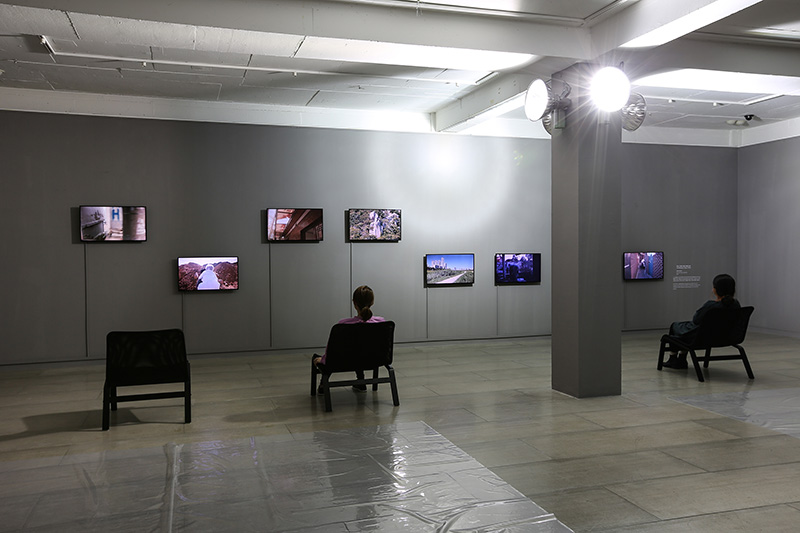 installation view The Wanderer's Song of Wind
installation view The Wanderer's Song of Wind
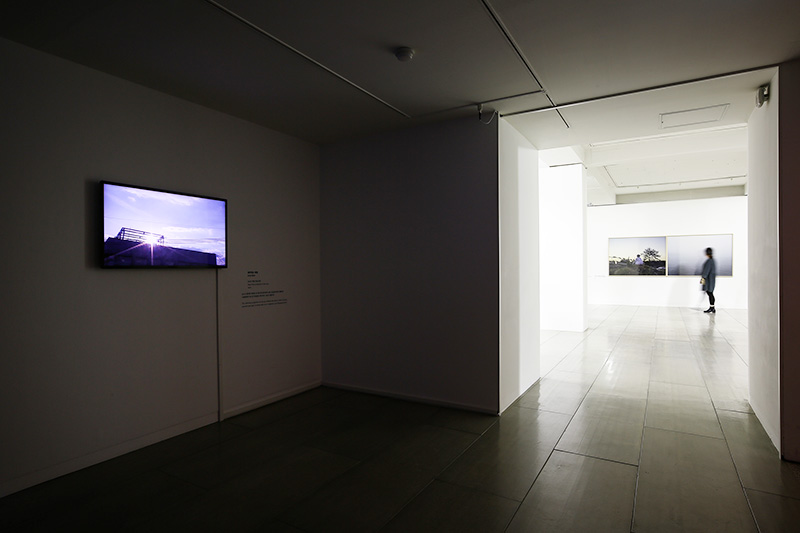 installation view Live Sun(left), Inner View(right)
installation view Live Sun(left), Inner View(right)
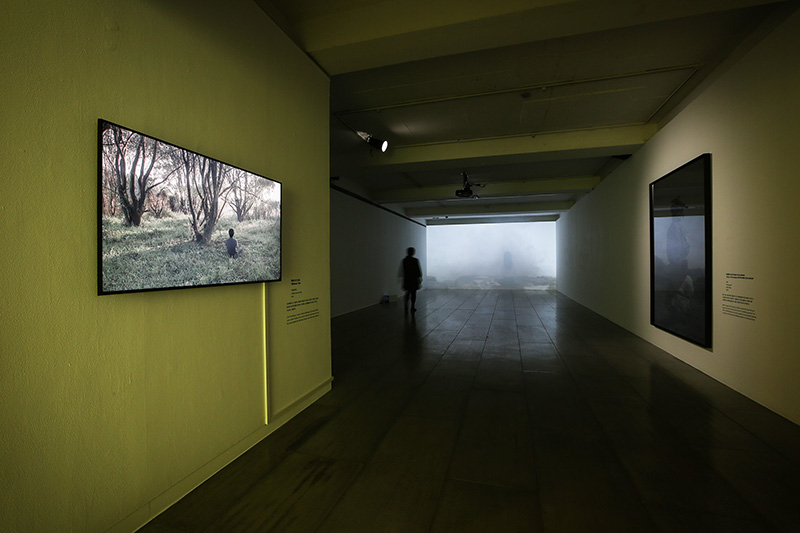 installation view A Man Who Became a Landscape(left), A Reverie in the Fog(middle), Tower of Nostalgia 37°81'38.98"N 126°24'54.48"E(right)
installation view A Man Who Became a Landscape(left), A Reverie in the Fog(middle), Tower of Nostalgia 37°81'38.98"N 126°24'54.48"E(right)
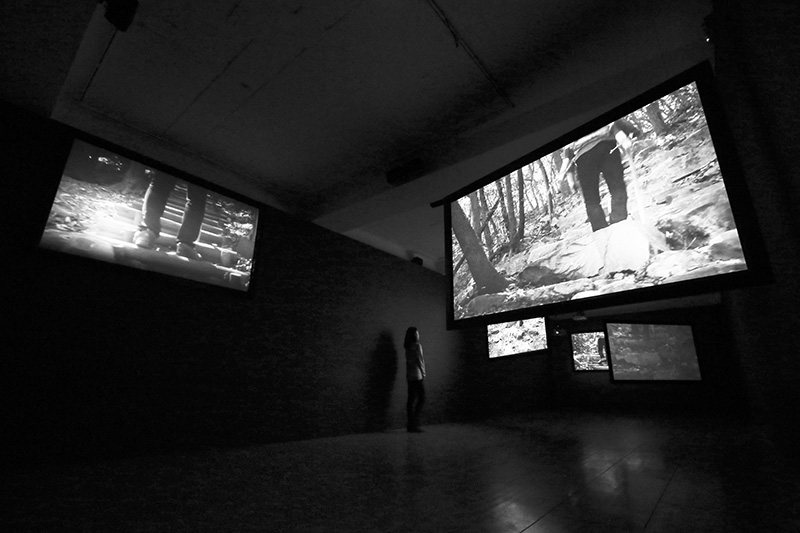 installation view My Meursault
installation view My Meursault
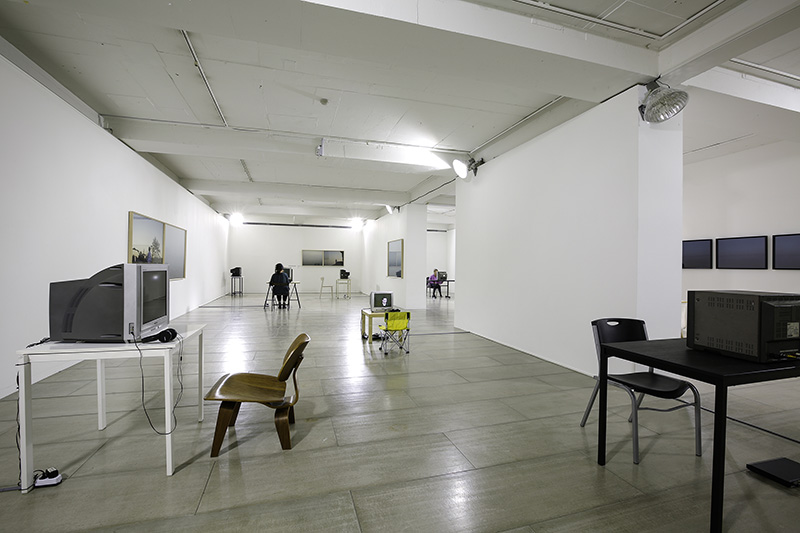 installation view Inner View
installation view Inner View